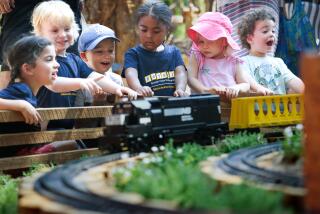‘Railfans’ Make Tracks to Admire Engineering Oddity
- Share via
What goes around comes around when you talk technology in Tehachapi.
Not the 21st century kind, depicted by the 5,000 futuristic-looking turbine propellers that line mountaintops east of town and spin in unison in the wind to generate electricity.
But the 19th century type: the stretch of rail track north of town that causes locomotives to cross over the cars they are pulling.
The Tehachapi Loop is a 3,799-foot-long rail circle that was built in 1876 to allow trains to cross the Tehachapi Mountains and travel between Los Angeles and the Bay Area.
Southbound trains making the Loop pass through a tunnel and then complete a tight, counterclockwise loop, gently climbing 77 feet before crossing back over the tunnel -- and above themselves.
The Loop conquered a troublesome ridge near the top of the 4,000-foot Tehachapi Summit by keeping the track grade at 2.2% -- the maximum that rail firms were willing to make steam engines climb.
Southern Pacific Railroad engineer William Hood designed the Loop as part of a 16-mile mountain track segment that included 18 tunnels totaling 8,240 feet in length.
Hood’s feat is observed everywhere in Tehachapi, located 115 miles north of Los Angeles in Kern County.
Two weeks ago the city of 6,780 dedicated its first historic mural: a 60-foot-wide, panoramic painting of the Loop on the side of the Tehachapi Lumber Co. that shows post-World War II locomotives passing over it. The depiction of that era is also a nod to another seminal event in Tehachapi: a disastrous 1952 earthquake.
The Red Caboose restaurant includes a coin-operated model of the Loop. A photographic history and Tehachapi Loop factoids cover the dining room wall of Kelcy’s Restaurant.
About 3,000 laborers from Canton, China, constructed the tracks. They were paid $26 a month and used 500 one-horse carts on the project.
The white cross in the center of the Loop (which is privately owned ranchland) is more contemporary. It was erected by railroad workers in memory of conductor Everett Crown and brakeman Allen Riess, killed in a 1989 derailment in San Bernardino.
At the corner of F and Haynes streets, a collection of old railroad signals stands in the backyard of the late Bill Stokoe, a railroad worker who collected them from the Loop and elsewhere along the summit track.
The antique semaphores and mechanical arms will be relocated to a railroad museum planned for the Tehachapi train station, said Doug Pickard, who runs the Trains Etc model train shop across the street from the faded building. Locals hope to refurbish the wooden station and finish the museum by 2004, the depot’s 100th anniversary.
The Loop itself is Tehachapi’s biggest draw. Pickard said that “railfans” -- hobbyists who photograph trains, collect locomotive numbers and count boxcars -- come from all over the world to see it.
“In four days guys will fly in from Japan, watch trains and then turn around and go home,” said Pickard, a former Long Beach aerospace engineer. “One man from the Bay Area comes every Labor Day and Memorial Day and hires a porta-potty for the other railfans to use down there.”
Tehachapi history buff Marjorie Miller said she and other locals are continually amazed by how devoted outsiders are to the Loop, whose 60 to 65 trains a day are said to make it the world’s busiest single-tracked mainline.
“It’s mind-boggling how many people go out there and sit and photograph them,” she said. “There are a tremendous number of railroad enthusiasts out there.”
On a hill overlooking the Loop, Nick Collins, a software administrator from Santa Clara, and John Pavelchak, a mall property manager from Lodi, N.J., watched reverently as a mile-long train passed over itself.
“I’ve seen this place on movies and videos. Now I’m here,” said Pavelchak. “It’s so beautiful,” Collins added.
Fred Hoeser, a Durand, Wis., pharmacist, was videotaping trains crossing the Loop for a friend in Australia. He had made a brief visit four years ago and failed to see any trains.
“I knew that day that they were doing track work and trains would not be running. But I wanted to be able to say I’d been here in case I never got back here again,” he explained.
But like others, Hoeser was concerned that this visit might be his last.
Over the last month, railroad officials have tightened security near tracks in response to reported terrorist threats to the nation’s transportation system. Train crews have been instructed to report “suspicious-looking” people to railroad police or local authorities.
Railfans across the country have reported being questioned and in some cases detained for taking pictures of trains and making notes of equipment and cargo they’ve seen.
One Texas train hobbyist was grilled by police and the FBI for five hours.
“I can understand authorities being concerned. But train crews ought to be able to pretty much tell who the good guys are,” Hoeser said of his fellow railfans.
John Bromley, a spokesman for Union Pacific Railroad, which operates the Tehachapi Loop tracks, said crews have been asked “to be vigilant and report trespassers and anything unusual.” But he said no railfan problems at the Loop have been listed on his company’s daily incident report.
Spokeswoman Lena Kent of Burlington Northern & Santa Fe, whose trains also use the Loop, declined to comment on security measures.
But Ron Pettit, the Union Pacific manager in charge of the Loop, said train buffs should expect no trouble if they don’t trespass on railroad property.
“If I tried to stop people from taking pictures at the Loop I’d probably be lynched,” he said.
“You should see the place on a holiday like Memorial Day. People are parked around it, watching trains. It looks like a KOA campground.”
More to Read
Sign up for Essential California
The most important California stories and recommendations in your inbox every morning.
You may occasionally receive promotional content from the Los Angeles Times.











